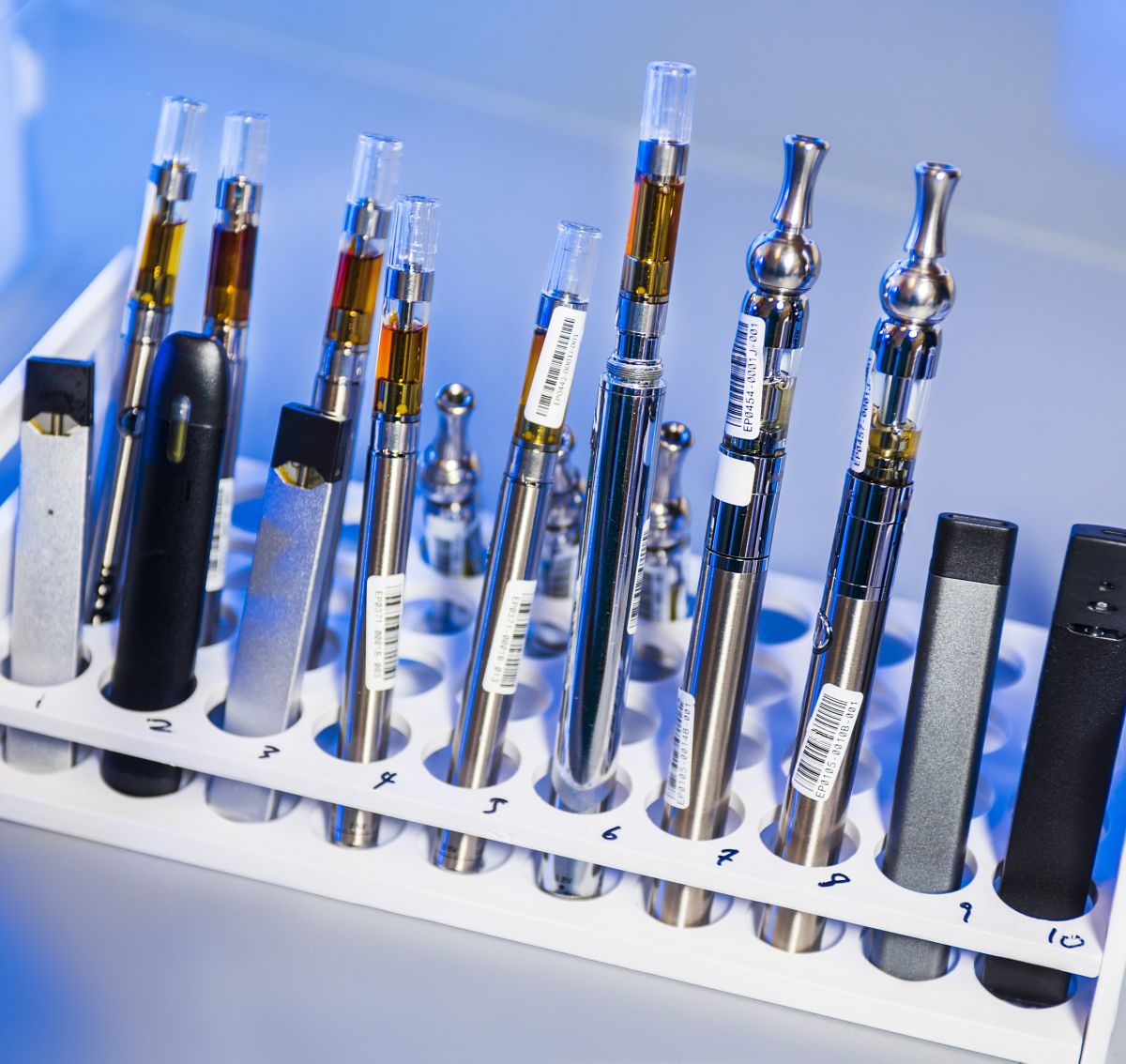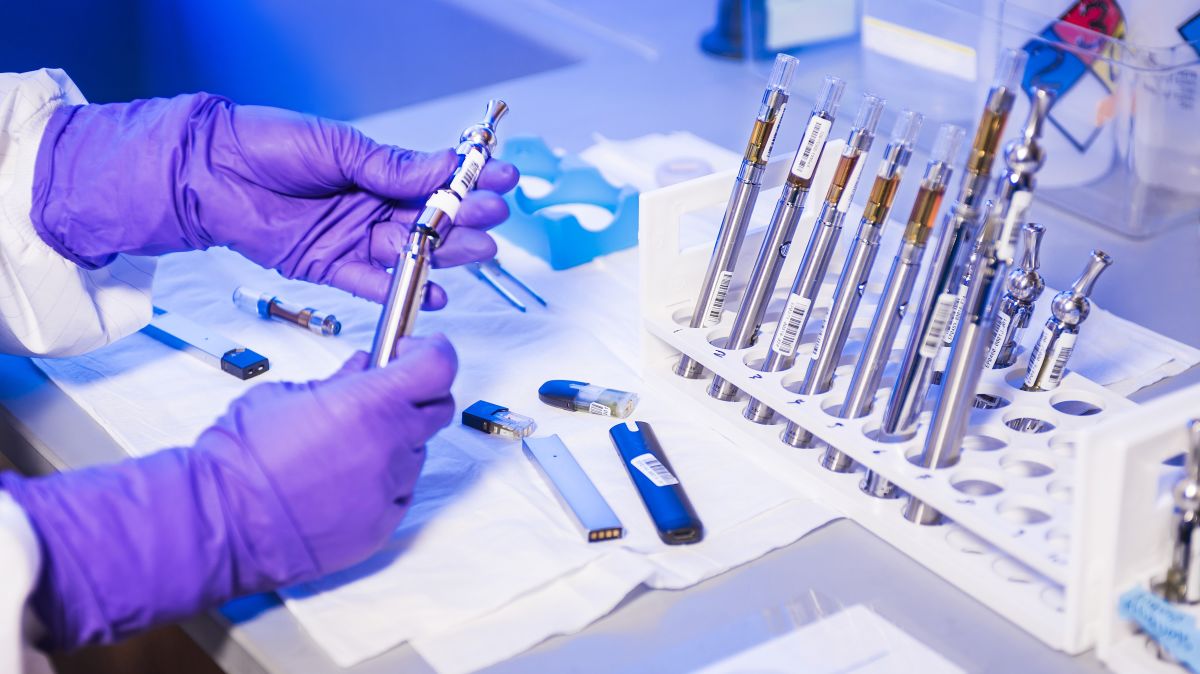E-Cigarettes/ Vaping

Electronic cigarette (e-cigarette) use is becoming more common during pregnancy, mainly because women falsely perceive vaping to be safer than tobacco cigarettes. Women who use e-cigarettes should try to quit during pregnancy – or ideally – before.
E-cigarettes contain dozens of chemicals that have yet to be studied in humans, let alone during pregnancy. Additionally, while there are more than 7,000 different flavors available, the main chemicals in these solutions have only been studied regarding oral ingestion, and not inhalation.
Additionally, nicotine is already known to be neurologically toxic to a fetus, and it is assessed that pregnant women may receive higher amounts of nicotine through the use of e-cigarettes than traditional cigarettes.
Further, nicotine is only one of numerous different identified chemicals in e-vapor; therefore, nicotine-free flavors still contain many other potentially harmful toxins.
Women may also experience severe lung injury during pregnancy with the use of e-cigarettes, which could predispose them even further to severe respiratory illness that could result in pregnancy-related complications.
Women who use vaping as a method to quit tobacco smoking should have a risks and benefits discussion with their HCP regarding other forms of smoking cessation tools during pregnancy. Women have the right to choose the best option for them – after understanding all risks involved – regarding their long-term health and the health of their pregnancy.
Background
Electronic cigarettes (e-cigarettes) initially hit the market around 2006 to potentially reduce the harmful effects of tobacco smoking. This recent emergence in the market is a hindrance to research regarding safety; therefore, the full-scale safety and effects of e-cigarette use during pregnancy remains largely unknown.
E-cigarette use is common in pregnant women, and even more common in women of reproductive age. It is estimated that up to 15% of pregnant women use e-cigarettes, which means that an estimated 570,000 fetuses are exposed to nicotine and other chemicals in e-cigarettes every year.
Smoking Cessation Tool
It has been frequently reported that pregnant women use e-cigarettes during pregnancy as a smoking cessation tool, due to beliefs that e-cigarettes are safer than smoking tobacco, especially for women who cannot give up nicotine completely. However:
E-cigarettes contain the same amount of nicotine (or more) than traditional cigarettes and nicotine carries its own risks; this is in addition to the possible toxic components of vapor and flavorings that are inhaled and likely passed to the fetus.

Further, there is evidence that e-cigarettes do not promote quitting, but rather lead to dual use of both e-cigarettes and tobacco cigarettes, compounding risk of harm.
E-cigarettes also likely produce more toxins than other forms of nicotine replacement therapy (NRT).
In addition, although more research is necessary, it is possible the perceived safety leads many women to use e-cigarettes more often, which indicates they would be consuming more nicotine (and other toxic vapor components) than tobacco cigarettes.
Regulation
The U.S. Food and Drug Administration (FDA) regulates the manufacturing, importing, packaging, labeling, and advertising of e-cigarettes, as well as the promotion, sale, and distribution of all their components and parts – excluding accessories (as of August 2016).
In January 2020, FDA issued a ban on fruit and mint flavors (but not menthol or tobacco) to lessen the appeal of e-cigarettes to youth. In the U.S., it is illegal for a retailer to sell any tobacco product – including cigarettes, cigars and e-cigarettes – to anyone under 21.
Note: There is no direct regulatory authority in the U.S. regarding flavorings, specifically, in e-cigarettes. Flavorings are approved for use in food but have not been studied or assessed in humans when inhaled.
In August and September 2019, a dramatic uptick in lung injuries in young adults was investigated by the FDA and U.S. Centers for Disease Control and Prevention (CDC). Investigation determined the outbreak was the result of e-cigarette, or vaping, product use-associated lung injury (EVALI).
As of February 18, 2020, a total of 2,807 hospitalized cases had been reported to CDC from all 50 states, the District of Columbia, Puerto Rico, and U.S. Virgin Islands, and 68 deaths had been confirmed in 29 states and the District of Columbia.
The median age of deceased patients was 49.5 years and ranged from 15 to 75 years; the mean age of hospitalized patients was 24 years.
Laboratory data indicated that vitamin E acetate, an additive in some THC-containing e-cigarette or vaping products, was strongly linked to the EVALI outbreak.
Vitamin E acetate does not cause harm when swallowed as a supplement or used on the skin; however, when inhaled, it can interfere with normal lung functioning.
Devices
E-cigarettes are hand-held battery-operated devices; some can be as small as a USB drive.
A battery is used to power an atomizer which vaporizes and aerosolizes liquid nicotine (in a variety of flavors) that is stored in a replaceable cartridge. The atomizer senses a change in pressure when the user inhales and delivers a “hit” of vaporized nicotine. E-cigarettes contain no tobacco.

There are more than 400 brands of e-cigarettes, but testing has been performed in only a few brands. Therefore, there is a significant lack of information regarding these devices during pregnancy, as well as different types of devices, manufacturers, nicotine amounts, different flavors, and varying chemical compositions.
The aerosol which is inhaled by the user typically contains nicotine, flavorings, and other additives; these flavoring components have not been studied, and more than 7,000 different flavors are available. These are “Generally Recognized as Safe” (GRAS) by the FDA, but again, this is for oral ingestion, not inhalation.
The flavorings are assessed to be converted to toxic and/or carcinogenic by-products when heated and inhaled; concentration levels are unknown and vary by brand.
GRAS: According to the FDA, "a substance that will be added to food is subject to premarket approval by FDA unless it is generally recognized, among qualified experts, to be safe under the conditions of its intended use".
However, one study not only determined concentrations were high enough to produce adverse effects, but also noted that a significant number of the flavor chemicals were aldehydes, a compound class recognized as "primary irritants" of mucosal tissue of the respiratory tract.
Additional research is necessary to determine the chemicals in e-cigarette flavorings and the effects these chemicals may have on an individual when inhaled. Flavored e-cigarette products do not typically list the major flavor chemicals present, nor their amounts/levels.
While there is no research on the inhalation of e-cigarette flavor chemicals and pregnancy, numerous chemicals in the vapor are already known to cross the placenta and affect the fetus.
Nicotine
When inhaled, nicotine can reach the brain within seconds.
The vapor is created from heating up a nicotine solution that also contains flavorings. Newer designs provide variable levels of voltage; higher voltage can deliver higher levels of nicotine.
As users become more experienced, they tend to take higher-volume puffs and obtain higher levels of nicotine equaling or exceeding the nicotine levels achieved by smokers of conventional cigarettes.
Nicotine passes through the placenta and enters the fetus at levels similar to or higher than the mother, affecting brain and lung development. Nicotine is assessed to be the primary factor that harms the fetus even in tobacco smoke.
Interestingly, some studies have seen prenatal lung and brain harm even from e-cigarettes that do not contain nicotine. This has led some authors to believe the hot vaping process and resulting aerosol could be more dangerous.
It is currently assessed that nicotine levels in second-hand e-cigarette vapor is less than nicotine levels in second-hand tobacco smoke. However, since most users believe that e-cigarettes are safer than tobacco smoke, pregnant women may experience a prolonged exposure to second-hand e-cigarette vapor, especially if those women are also users themselves.
Vapor/Aerosol
Nicotine solutions (and even solutions without nicotine) deliver nicotine along with a mix of other aerosolized chemicals, some of which are known to be toxic. No studies have determined the long-term health effects of these chemicals, let alone their harm during pregnancy.
Studies using gas chromatography mass spectrometry have identified the main components of e-cigarettes as nicotine, propylene glycol, and vegetable glycerin; trace amounts of nitrosamines and diethylene glycol have also been detected.

Propylene glycol and vegetable glycerin are often used as humectants, which prevent the loss of moisture. Humectants are also used in lotions and cosmetics, as well as foods. Long-term health exposure to these ingredients through the use of e-cigarettes has not been studied.
Propylene glycol [CDC] is a syrupy, colorless, and tasteless solution that must be heated or briskly shaken to produce a vapor. It can also be inhaled when used to create artificial fog and smoke. Propylene glycol breaks down in the body with 48 hours but can cause irritation to the mucus membranes of the eyes, nose, skin, and mouth with long-term exposure.
Although there is debate regarding the levels of various compounds found in vapor, humectants can be oxidized to produce toxic carbonyl compounds, formaldehyde, acetaldehyde and acrolein, which have been detected in the e-vapor as well as in the exhaled breath after e-vaping.
Heavy metals such as chromium, cadmium, lead, nickel, arsenic, tin and copper have also been detected in the vapor in wide ranges.
Pregnancy-Specific Effects
No clinical human trials have been conducted on the effect of vaping during pregnancy specifically on the health of the fetus or infant, but it is assessed the fetus is adversely affected in at least the same way as tobacco smoke.
Further, it is assessed that embryos may be more sensitive to e-cigarette use than adult tissue, as a result of the combination of nicotine and/or other chemicals present in the vapor. E-cigarette use has also been linked to implantation failure and growth restriction of the fetus, due to reduced blood flow in both the uterus and umbilical cord, as well as neurological consequences.
An animal study published in October 2022 showed that prenatal exposure to e-cigarette vapor, regardless of nicotine presence, causes consequences in lung function and structure that persists in the offspring to adulthood.
An animal study published in September 2021 indicated that cinnamon-flavored electronic cigarette vapor can affect cardiovascular function during early embryonic development, even in the absence of nicotine, particularly at elevated exposure concentrations.
A study published in July 2021 identified an independent association between low birth weight (not just a smaller baby; can result in complications) and e-cigarette use during the last three months of pregnancy. "Electronic cigarette use during pregnancy, particularly when used daily by those who do not also smoke tobacco cigarettes, may adversely influence birth outcomes, and pregnant individuals should be directed toward evidence-based cessation strategies (eg, quitlines, cessation counseling, medications)."

Some of the adverse associations with fetal development are likely due to inflammation. Further, it is theorized that e-cigarette exposure during pregnancy induces an abnormal inflammatory environment in the lungs of both the mothers and fetus/newborn.
Short-term e-vaping has also been shown to impair pulmonary function and cardiovascular outcomes which could increase the risk of adverse pregnancy outcomes.
Inflammation of the lungs can be particularly dangerous during pregnancy, especially regarding influenza and COVID-19. Influenza and COVID-19 are documented to be more severe during pregnancy (depending on numerous factors) and at least one additional study has shown that vaping may increase influenza risk even further (and therefore, potentially COVID-19 as well). A study that exposed mice to three months of e-vapor and influenza had significant lung inflammation and tissue damage.
Management/Guidelines
Although e-cigarettes are advertised as “healthier” alternatives to tobacco smoking, accumulating research since their emergence on the market is starting to significantly cast doubt on this claim. E-cigarettes are also reviving and renormalizing young adults to nicotine addiction.
The CDC, U.S. Preventive Services Task Force, and the 2016 U.S. Surgeon General report state that e-cigarettes, due to their unproven safety or efficacy, should not be considered safe to use in pregnancy, and that e-cigarette flavorings may be harmful (reaffirmed in 2021).
In Canada and Australia, there are no recommendations for e-cigarette use in pregnancy, but their health organizations state that evidence on the safety of NRT in pregnancy is limited.
NRT is not well studied during pregnancy, and based on nicotine metabolism during pregnancy, requires significant more research. However, the FDA has indicated that various approved nicotine replacement therapies (see Resources) can be considered during pregnancy under close supervision of an HCP.
In the United Kingdom, it is recommended that pregnant women should not be discouraged from using e-cigarettes for stopping smoking if they have struggled to quit with alternative cessation aids.
Pregnant women should understand the risks of both tobacco smoking and e-cigarette use, should be offered all available options to quit smoking, and should have a risks and benefits discussion with their HCP regarding the best individualized methods to help them quit smoking and/or vaping during pregnancy.
Action
As stated above, women need to talk to their HCP to get help and support to quit smoking and/or vaping during pregnancy.
Women should also talk to their partner/family members who smoke/vape and live in the same household. Second-hand smoke can cause just as many complications during pregnancy, and couples/family members who quit together have better success.
Women who use traditional cigarettes should read more information here.
Partner/Support
Partners, family members, or friends who live in the same household as a pregnant woman should not vape in front of her, around her, or at all. It is often recommended, for the long-term health of all involved, that couples attempt to quit together during pregnancy (ideally, before pregnancy).
If a pregnant woman does not have a supportive partner, including a partner who smokes or who does not support her attempts to quit, complications can increase, along with emotional and possible depressive symptoms for the woman.
Resources
Tobacco and Nicotine Cessation During Pregnancy: Committee Opinion 807 (American College of Obstetricians and Gynecologists; May 2020)
Vaping during Pregnancy: Not Just a Bunch of Smoke (MotherToBaby.org)
Want to Quit Smoking? FDA-Approved Products Can Help (U.S. Food and Drug Administration)
E-cigarettes (Vaping): Fact Sheet (MotherToBaby.org)
Electronic Cigarettes (U.S. Centers for Disease Control and Prevention)
Outbreak of Lung Injury Associated with the Use of E-Cigarette, or Vaping, Products (U.S. Centers for Disease Control and Prevention)
Avoid Battery Explosions (FDA)